Combinations
of Resistors
Resistors do not occur in isolation. They are almost always part
of a larger circuit, and frequently that larger circuit contains many resistors.
It is often the case that resistors occur in combinations that repeat.
Goals
What
are our goals for this lesson? Here are some.

Given a circuit with a number of resistors,

Be able to determine resistor combinations within the circuit where
two or more resistors can be combined.

Be able to replace series and parallel resistor combinations with the correct
equivalent resistors.
Combinations of Resistors
In this lesson we will look at two recurring resistor combinations, series
combinations and parallel combinations. Those are common combinations,
not only for resistors but other elements as well. (For example,
we can speak of "a resistor in series with a capacitor".)
We'll start by examining series and parallel combinations and then move
on to identifying those combinations when they are "buried" within a larger
circuit. What we're doing is learning how to recognize small portions
of larger circuits. Experts do that.
Series Combinations of Resistors
Two elements are said to be in series whenever the same current physically
flows through both of the elements. The critical point is that the
same current flows through both resistors when two are in series.
The particular configuration does not matter. The only thing that
matters is that exactly the same current flows through both resistors.
Current flows into one element, through the element, out of the element
into the other element, through the second element and out of the second
element. No part of the current that flows through one resistor "escapes"
and none is added. This figure shows several different ways that
two resistors in series might appear as part of a larger circuit diagram.
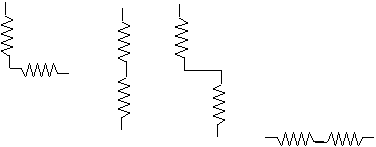
Questions
Here is a circuit you may have seen before. Answer the questions
below for this circuit.
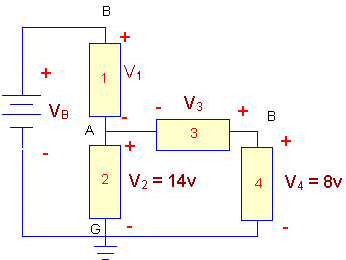
Q1. Are
elements #3 and #4 in series?
Q2. Are
elements #1 and #2 in series?
Q3. Is
the battery in series with any element?
You might wonder just how often you actually find resistors in series.
The answer is that you find resistors in series all the time.
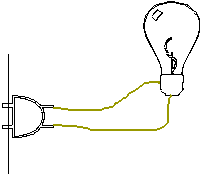
An example of series resistors is in house wiring. The leads from
the service entrance enter a distribution box, and then wires are strung
throughout the house. The current flows out of the distribution box,
through one of the wires, then perhaps through a light bulb, back through
the other wire. We might model that situation with the circuit diagram
shown below.
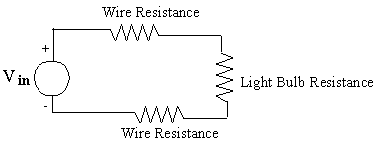
In many electronic circuits series resistors are used to get a different
voltage across one of the resistors. We'll look at those circuits,
called voltage dividers, in a short while. Here's
the circuit diagram for a voltage divider.
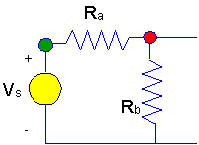
Besides resistors in series, we can also have other elements in series
- capacitors, inductors, diodes. These elements can be in series
with other elements. For example, the simplest form of filter, for
filtering low frequency noise out of a signal, can be built just by putting
a resistor in series with a capacitor, and taking the output as the capacitor
voltage.
As we go along you'll have lots of opportunity to use and to expand what
you learn about series combinations as you study resistors in series.

Let's look at the model again. We see that the wires are actually small
resistors (small value of resistance, not necessarily physically small)
in series with the light bulb, which is also a resistor. We have
three resistors in series although two of the resistors are small.
We know that the resistors are in series because all of the current that
flows out of the distribution box through the first wire also flows through
the light bulb and back through the second wire, thus meeting our condition
for a series connection. Trace that out in the circuit diagram and
the pictorial representation above.
Let us consider the simplest case of a series resistor connection, the
case of just two resistors in series. We can perform a thought experiment
on these two resistors. Here is the circuit diagram for the situation
we're interested in.

Imagine that they are embedded in an opaque piece of plastic, so that we
only have access to the two nodes at the ends of the series connection,
and the middle node is inaccessible. If we measured the resistance of the
combination, what would we find? To answer that question we need
to define voltage and current variables for the resistors. If we
take advantage of the fact that the current through them is the same (Apply
KCL at the interior node if you are unconvinced!) then we have the situation
below.
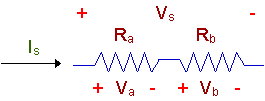
Note that we have defined a voltage across
each resistor (Va and Vb) and current
that flows through both resistors (Is) and a voltage
variable, Vs, for the voltage that appears across the
series combination.
Let's list what we know.
-
The current through the
two resistors is the same.
-
The voltage across the
series combination is given by:
-
The voltages across the
two resistors are given by Ohm's Law:
We
can combine all of these relations, and when we do that we find the following.
-
Vs=
Va + Vb
-
Vs=
Is Ra + Is
Rb
-
Vs=
Is (Ra + Rb)
-
Vs=
Is Rseries
Here, we take Rseries
to be the series equivalent of the two resistors
in series, and the expression for Rseries
is:
Rseries
= Ra + Rb
What do we mean by series equivalent? Here are some points to observe.
-
If current and voltage
are proportional, then the device is a resistor.
-
We have shown thatVs=
Is Rseries,
so that voltage is proportional to current, and the constant of proportionality
is a resistance.
-
We will call that the
equivalent
series resistance.
|

